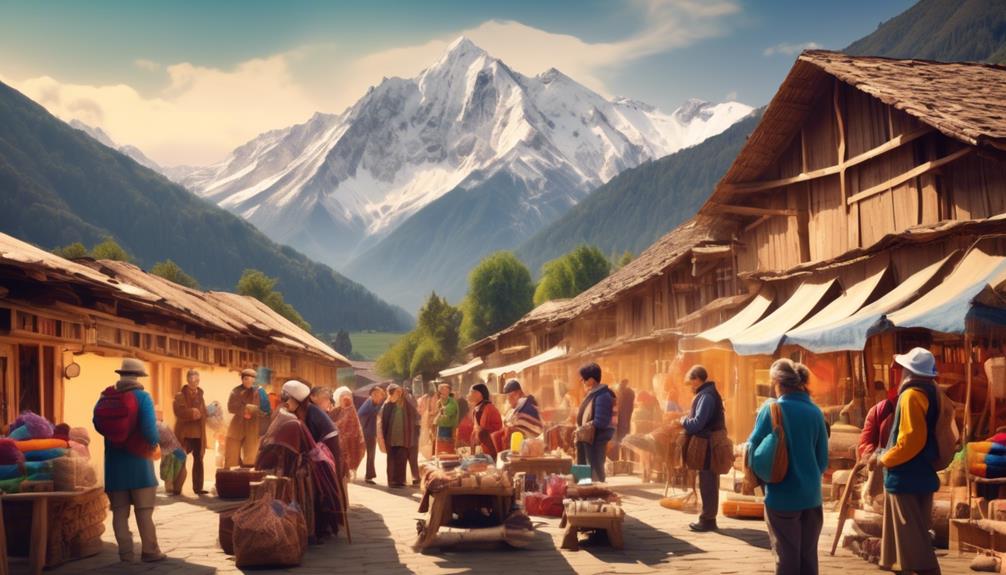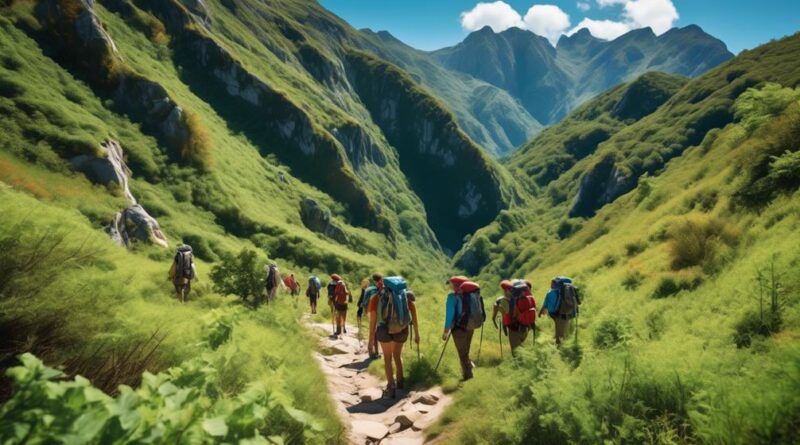6 Best Practices for Sustainable Mountain Trekking
Did you know that over 200 million people visit mountainous areas each year for trekking and hiking?
With such a large number of visitors, it's crucial to ensure that these activities are conducted sustainably to minimize their impact on the environment.
By adopting the six best practices for sustainable mountain trekking, you can not only enjoy the beauty of these natural landscapes but also contribute to their preservation for future generations.
Choosing Sustainable Gear
When selecting gear for mountain trekking, prioritize sustainability by choosing items made from environmentally friendly materials and produced using ethical manufacturing practices. Opt for gear made from eco-friendly materials such as organic cotton, hemp, recycled polyester, and sustainable wool. These materials reduce the environmental impact of production and are often biodegradable or recyclable at the end of their lifecycle. Additionally, look for gear that's certified by organizations such as Bluesign or Global Organic Textile Standard (GOTS) to ensure that ethical production practices were followed.
When it comes to clothing, seek out items made from organic cotton, which is grown without the use of synthetic pesticides and fertilizers, minimizing harm to both the environment and workers. Similarly, clothing made from hemp is a great sustainable option as it requires minimal water and no pesticides to grow. For outerwear, consider products made from recycled polyester, which helps reduce plastic waste in landfills and oceans. Furthermore, gear constructed from sustainable wool, sourced from ethically treated sheep, provides insulation and durability while supporting responsible land management.
In addition to materials, consider the production practices of the gear you choose. Look for companies that prioritize fair labor conditions, safe working environments, and sustainable manufacturing processes. By supporting brands that uphold these ethical standards, you contribute to the promotion of responsible and sustainable practices within the outdoor industry.
Making informed choices about the gear you bring on your mountain treks can have a positive impact on the environment and promote a more sustainable outdoor recreation culture.
Minimizing Waste on the Trail
To continue your commitment to sustainability on the trail, focus on minimizing waste by packing reusable containers and opting for products with minimal packaging. Reducing packaging starts with thoughtful planning. Instead of individually wrapped snacks, choose larger packages or buy in bulk and use reusable containers to portion them out. This not only cuts down on packaging waste but also reduces the weight of your pack.
When it comes to meals, select dehydrated or freeze-dried food in minimal packaging and transfer them to reusable bags. Additionally, consider composting organic waste such as fruit peels and leftover food. Bring a small, sealable container to collect this waste and dispose of it properly when you reach a designated composting area or back at your campsite.
Furthermore, be mindful of your toiletry items. Choose multi-purpose products to minimize the number of containers you need to carry. Opt for biodegradable soap and shampoo to reduce the environmental impact. Remember to pack out all waste, including hygiene products and toilet paper, in a sealable bag.
Respecting Wildlife and Flora

Respecting wildlife and flora involves treading lightly and observing from a distance to minimize disturbance to their natural habitats. When trekking through mountainous areas, it's essential to adhere to best practices for wildlife conservation and flora protection. Here are some key guidelines to follow:
- Observe from a Distance: When encountering wildlife, maintain a respectful distance to avoid causing stress or disruption to their natural behaviors. Using binoculars or camera zoom lenses allows you to appreciate wildlife without encroaching on their space.
- Stay on Designated Trails: Venturing off established paths can lead to trampling of delicate flora, and it may disturb nesting sites or habitats of small animals. By sticking to designated trails, you can minimize your impact on the local ecosystem.
- Pack Out All Waste: Properly dispose of any litter and waste to prevent harm to wildlife and plants. Even biodegradable items can disrupt the balance of the environment, so it's crucial to carry out everything you bring in, leaving no trace of your presence.
Following Leave No Trace Principles
Adhere to the principles of Leave No Trace to minimize your impact on the environment while trekking through mountainous areas.
When it comes to campsite etiquette, it's crucial to set up camp in established campsites whenever possible. This helps to concentrate impact and prevent the creation of new campsites, which can lead to habitat destruction. If established campsites aren't available, choose a durable surface such as rock, gravel, or snow to pitch your tent. This helps minimize the damage to vegetation and soil.
In terms of waste management, always pack out all of your trash and leftover food. Leaving waste behind not only damages the natural environment but can also harm wildlife. Be sure to bring along a sealable bag for packing out toilet paper and human waste, and always dispose of it properly when you reach a designated waste facility. When washing dishes or yourself, make sure to do so at least 200 feet away from any water source to prevent contamination. Use biodegradable soap sparingly or opt for soap-free cleaning methods.
Following Leave No Trace principles is vital for preserving the natural beauty of mountainous areas and minimizing our impact on the environment. By being mindful of campsite etiquette and practicing proper waste management, you can ensure that future generations can continue to enjoy these stunning landscapes.
Supporting Local Communities

When trekking through mountainous areas, you can contribute to the preservation of these stunning landscapes by actively supporting local communities. Engaging with local communities not only enriches your trekking experience but also has a positive economic impact on the people living in these areas.
Here are three ways you can support local communities during your mountain trekking adventures:
- Community engagement: Take the time to learn about the local culture and customs of the communities you encounter during your trek. Engaging with locals, whether it's through purchasing their handmade crafts or simply having a conversation with them, can foster mutual respect and understanding. This can also lead to meaningful cultural exchanges, enriching your experience and leaving a positive impression on the community.
- Economic impact: Contribute to the local economy by supporting small businesses and local vendors. Whether it's buying supplies, hiring local guides, or dining at family-owned restaurants, your financial support directly benefits the community. This helps create sustainable livelihoods, reduces dependency on external aid, and empowers local residents to take ownership of their economic future.
- Responsible tourism: Be mindful of the impact of your presence on the local environment and community. Practice responsible and sustainable tourism by respecting local regulations, minimizing waste, and being considerate of the natural and cultural heritage of the area. This ensures that future generations can continue to benefit from the beauty and resources of the region.
Understanding Trail Sustainability
To ensure the preservation of mountain trails and their surrounding ecosystems, it's essential to prioritize sustainable practices in trail maintenance and usage. Trail sustainability encompasses various aspects such as trail maintenance, erosion control, sustainable trail design, and water management.
Effective trail maintenance is crucial for preserving the natural integrity of mountain trails. Regular upkeep, such as clearing debris and repairing damaged sections, helps minimize the environmental impact of trekking activities. It's also important to employ erosion control techniques to prevent soil degradation and loss of vegetation along the trails. This can involve the strategic placement of barriers and vegetation to stabilize soil and reduce the risk of erosion, particularly on steep or heavily trafficked paths.
Furthermore, sustainable trail design plays a significant role in minimizing the ecological footprint of trekking. Thoughtful trail layouts can help prevent unnecessary environmental disruption, and integrating natural features into the design can enhance the overall hiking experience while preserving the surrounding environment. Additionally, water management is essential for maintaining trail sustainability. Proper drainage systems and the implementation of measures to prevent water accumulation on trails can help mitigate erosion and ensure the longevity of the trails.
Understanding and implementing sustainable trail practices are vital for the long-term preservation of mountain ecosystems and ensuring that future generations can continue to enjoy these natural treasures.
Practicing Responsible Camping

For responsible camping in mountainous areas, it's important to minimize your impact on the environment by following Leave No Trace principles and abiding by any specific camping regulations set forth for the area. When practicing responsible camping, adhere to campsite etiquette and promote eco-friendly camping practices.
Here are some key points to consider:
- Leave No Trace: Always follow the principles of Leave No Trace, which include packing out all trash, minimizing campfire impacts, respecting wildlife, and being considerate of other visitors. This ensures that the natural beauty of the mountainous area remains unspoiled.
- Campfire Responsibility: If campfires are allowed in the area, exercise caution and responsibility. Only build fires in designated fire rings or areas, use locally sourced firewood to prevent the spread of invasive species, and ensure the fire is completely extinguished before leaving the campsite.
- Campsite Etiquette: Be mindful of where you set up your campsite. Choose durable surfaces for tents, such as established camping areas or bare ground, to minimize the impact on vegetation. Avoid trampling on fragile plants and grasses, and maintain a respectful distance from water sources to prevent contamination.
Promoting Environmental Education
Encourage fellow trekkers to take part in environmental education initiatives to raise awareness about the delicate ecosystems of mountainous regions and the importance of preserving them for future generations. By participating in outdoor ethics and eco-friendly initiatives, you can actively contribute to the conservation of these stunning landscapes.
Engage in organized educational programs or simply take the initiative to share your knowledge with others during your treks.
When you're out trekking, make it a point to practice outdoor ethics. This includes leaving no trace by properly disposing of waste and minimizing your impact on the environment. Additionally, support and participate in eco-friendly initiatives such as tree planting, trail maintenance, and wildlife habitat restoration.
By getting involved in these activities, you not only contribute to the well-being of the mountain ecosystems but also set an example for others to follow.
Take the opportunity to educate yourself and others about the importance of sustainable trekking practices. Learn about local flora and fauna, understand the effects of climate change on mountain environments, and familiarize yourself with the principles of Leave No Trace.
Share this knowledge with your fellow trekkers to collectively promote responsible and eco-conscious behavior.
Frequently Asked Questions
How Can I Ensure My Trekking Experience Is Culturally Sensitive to the Local Communities?
To ensure your trekking experience is culturally sensitive, respect local customs and traditions, engage with the community, and practice responsible tourism. Show cultural awareness by learning about local customs and interacting respectfully with the community.
What Are Some Common Misconceptions About Sustainable Mountain Trekking That I Should Be Aware Of?
Common misconceptions about sustainable mountain trekking include underestimating the environmental impact, neglecting sustainable practices, and overlooking local traditions. It's important to be aware of these to ensure a respectful and responsible trekking experience.
Are There Any Specific Guidelines for Interacting With Wildlife That I Should Follow While Trekking in the Mountains?
When trekking in the mountains, it's crucial to follow specific guidelines for interacting with wildlife. Practice ethical photography, responsible waste disposal, and leave no trace to ensure minimal impact on the environment.
How Can I Contribute to Ongoing Environmental Conservation Efforts in the Areas Where I Am Trekking?
To contribute to ongoing environmental conservation efforts in the areas where you are trekking, consider community engagement and conservation projects. Get involved in local initiatives, support sustainable tourism, and participate in environmental clean-up efforts to make a positive impact.
What Are Some Ways to Minimize My Impact on the Natural Landscape While Still Enjoying My Trekking Experience?
To minimize your impact on the natural landscape while trekking, focus on minimizing waste and following leave no trace principles. Pack out all trash, avoid disturbing wildlife, and stay on designated trails to preserve the environment.
Conclusion
So, next time you head out for a mountain trek, remember to pack sustainable gear, minimize waste, respect wildlife and flora, and follow Leave No Trace principles.
Support local communities, understand trail sustainability, and practice responsible camping.
Promote environmental education and incorporate these best practices into your trekking adventures.
By doing so, you can help preserve the natural beauty of the mountains for generations to come.
Happy trekking!
